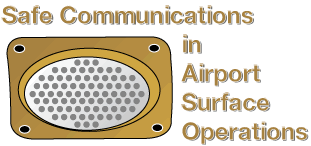 |
||||||||
| Issue Number 256 |
December
2000
|
|||||||
|
P.O. Box 189, Moffett Field, CA 94035-0189 |
||||||||
|
|
||||||||
 |
||||||||
| Issue Number 256 |
December
2000
|
|||||||
|
P.O. Box 189, Moffett Field, CA 94035-0189 |
||||||||
|
|
||||||||
 ASRS
is currently conducting a "structured callback" (telephone
survey) study for the FAA on runway incursion incidents that occur
at uncontrolled airports, or airports at which the Tower is closed
during nighttime and early morning hours. A recent controller’s
report to ASRS offers insight into why some runway incursion incidents
and ground conflicts occur when the Tower is not operating.
ASRS
is currently conducting a "structured callback" (telephone
survey) study for the FAA on runway incursion incidents that occur
at uncontrolled airports, or airports at which the Tower is closed
during nighttime and early morning hours. A recent controller’s
report to ASRS offers insight into why some runway incursion incidents
and ground conflicts occur when the Tower is not operating.
The Common Traffic Advisory Frequency (CTAF) is a frequency designed to carry out airport advisory practices while operating to or from uncontrolled airports. The CTAF may be a UNICOM, Multicom, FSS, or Tower frequency. It is clearly identified in VFR Terminal Area and sectional charts, the Airport/Facility Directory, Jeppesen Low Altitude Enroute charts, and other aeronautical publications used by general aviation and air transport pilots.
If a pilot operating at an uncontrolled field sees the movement of other aircraft, but doesn't hear anything on frequency, this may indicate that the pilot has tuned an incorrect CTAF frequency.
![]()
The FAA and many pilot organizations have given much attention in recent months to prevention of runway incursions involving aircraft. However, these events may also involve pedestrians, as a general aviation pilot discovered after parking his aircraft at a new FBO.
In 1999, the most recent complete year for which the FAA has collected runway incursion data, Vehicle-Pedestrian deviations accounted for 19% of all runway incursion events. Pilots who find themselves in our reporter’s situation should resist walking or driving across the airport surface. Help is usually just a phone call (or radio call) away.

"The weather outside is frightful," begins a popular holiday song. A general aviation pilot who experienced frightful winter weather tells an unusual story of how his aircraft became a grounded "snow bird":
Our reporter correctly outlines his own responsibility to properly plan and execute his flight. He apparently didn’t realize that a Center controller may not be aware of a local airport’s operational status unless it affects the Center’s operations.
Berm Steer
Darkness and blowing snow obscured taxiway markings and reduced forward visibility as a B-737 left the gate. The flight crew attempted to follow the proper taxi route to the runway by taxiing parallel to a snow berm left by plows that had cleared the ramp earlier. The Captain describes what happened next:
The Captain added that the aircraft was finally freed by a company recovery team that used two snowplows and large cables around the main gear struts. He acknowledged that the crew should have stopped the aircraft when they could not see the taxi lines and requested a guide vehicle.

Holiday safety rules for the passenger cabin:
|
ASRS Recently Issued Alerts On...
|
|---|
| Recurring flap control unit fault on a EMB-120 |
| Cessna 560X emergency pressure valve failure |
| LAHSO operation incident at a major Northeast Airport |
| An airport group on a runway during an air carrier landing |
| Jet Strean 3200 uncommanded inflight engine spooldown |
|
|
|
|---|---|
|
Air
Carrier/Air Taxi Pilots
|
2,276
|
|
General
Aviation Pilots
|
701
|
|
Controllers
|
108
|
|
Cabin/Mechanics/Military/Other
|
202
|
|
TOTAL
|
3,387
|